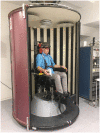Beyond sensory conflict: The role of beliefs and perception in motion sickness
- PMID: 33465124
- PMCID: PMC7815099
- DOI: 10.1371/journal.pone.0245295
Beyond sensory conflict: The role of beliefs and perception in motion sickness
Abstract
Illusory self-motion often provokes motion sickness, which is commonly explained in terms of an inter-sensory conflict that is not in accordance with previous experience. Here we address the influence of cognition in motion sickness and show that such a conflict is not provocative when the observer believes that the motion illusion is indeed actually occurring. Illusory self-motion and motion sickness were elicited in healthy human participants who were seated on a stationary rotary chair inside a rotating optokinetic drum. Participants knew that both chair and drum could rotate but were unaware of the actual motion stimulus. Results showed that motion sickness was correlated with the discrepancy between participants' perceived self-motion and participants' beliefs about the actual motion. Together with the general motion sickness susceptibility, this discrepancy accounted for 51% of the variance in motion sickness intensity. This finding sheds a new light on the causes of visually induced motion sickness and suggests that it is not governed by an inter-sensory conflict per se, but by beliefs concerning the actual self-motion. This cognitive influence provides a promising tool for the development of new countermeasures.
Conflict of interest statement
The authors have declared that no competing interests exist.
Figures



Similar articles
-
Optokinetic drum tilt hastens the onset of vection-induced motion sickness.Aviat Space Environ Med. 2003 Apr;74(4):315-9. Aviat Space Environ Med. 2003. PMID: 12688448
-
Rotation velocity change and motion sickness in an optokinetic drum.Aviat Space Environ Med. 2006 Aug;77(8):811-5. Aviat Space Environ Med. 2006. PMID: 16909874 Clinical Trial.
-
Visual blur and motion sickness in an optokinetic drum.Aerosp Med Hum Perform. 2015 May;86(5):440-4. doi: 10.3357/AMHP.4105.2015. Aerosp Med Hum Perform. 2015. PMID: 25945660
-
Motion sickness.Handb Clin Neurol. 2016;137:371-90. doi: 10.1016/B978-0-444-63437-5.00027-3. Handb Clin Neurol. 2016. PMID: 27638085 Review.
-
Simulated viewpoint jitter shakes sensory conflict accounts of vection.Seeing Perceiving. 2011;24(2):173-200. doi: 10.1163/187847511X570817. Seeing Perceiving. 2011. PMID: 21864457 Review.
Cited by
-
Assessment of vestibulo-ocular reflex and its adaptation during stop-and-go car rides in motion sickness susceptible passengers.Exp Brain Res. 2023 Jun;241(6):1523-1531. doi: 10.1007/s00221-023-06619-4. Epub 2023 Apr 25. Exp Brain Res. 2023. PMID: 37097301 Free PMC article.
-
Influence of Normal Aging and Multisensory Data Fusion on Cybersickness and Postural Adaptation in Immersive Virtual Reality.Sensors (Basel). 2023 Nov 26;23(23):9414. doi: 10.3390/s23239414. Sensors (Basel). 2023. PMID: 38067787 Free PMC article.
-
Relating individual motion sickness levels to subjective discomfort ratings.Exp Brain Res. 2022 Apr;240(4):1231-1240. doi: 10.1007/s00221-022-06334-6. Epub 2022 Feb 22. Exp Brain Res. 2022. PMID: 35192043 Free PMC article.
-
Unstable Gaze in Functional Dizziness: A Contribution to Understanding the Pathophysiology of Functional Disorders.Front Neurosci. 2021 Jul 20;15:685590. doi: 10.3389/fnins.2021.685590. eCollection 2021. Front Neurosci. 2021. PMID: 34354560 Free PMC article.
-
A New Vestibular Stimulation Mode for Motion Sickness With Emphatic Analysis of Pica.Front Behav Neurosci. 2022 May 4;16:882695. doi: 10.3389/fnbeh.2022.882695. eCollection 2022. Front Behav Neurosci. 2022. PMID: 35600993 Free PMC article.
References
MeSH terms
LinkOut - more resources
Full Text Sources
Other Literature Sources
Medical

